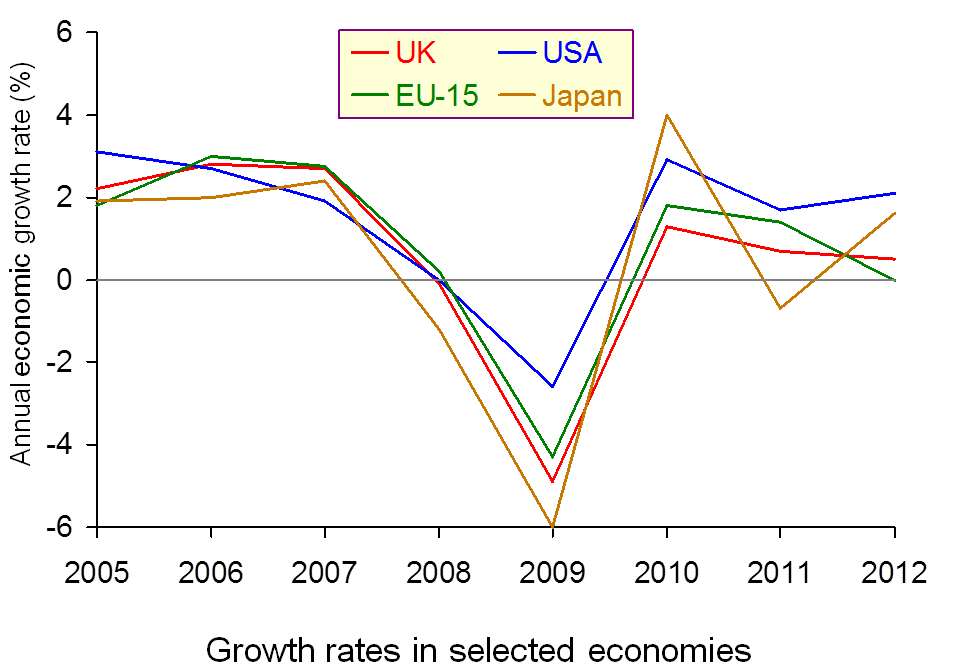 What lies ahead for economic growth in 2013 and beyond? And what policies should governments adopt to aid recovery? These are questions examined in four very different articles from The Guardian.
What lies ahead for economic growth in 2013 and beyond? And what policies should governments adopt to aid recovery? These are questions examined in four very different articles from The Guardian.
The first is by Nouriel Roubini, Professor of Economics at New York University’s Stern School of Business. He was one of the few economists to predict the collapse of the housing market in the USA in 2007 and the credit crunch and global recession that followed. He argues that continuing attempts by banks, governments and individuals to reduce debt and leverage will mean that the advanced economies will struggle to achieve an average rate of economic growth of 1%. He also identifies a number of other risks to the global economy.
 In contrast to Roubini, who predicts that ‘stagnation and outright recession – exacerbated by front-loaded fiscal austerity, a strong euro and an ongoing credit crunch – remain Europe’s norm’, Christine Lagarde, head of the IMF and former French Finance Minister, predicts that the eurozone will return to growth. ‘It’s clearly the case’, she says, ‘that investors are returning to the eurozone, and resuming confidence in that market.’ Her views are echoed by world leaders meeting at the World Economic Forum in Davos, Switzerland, who are generally optimistic about prospects for economic recovery in the eurozone.
In contrast to Roubini, who predicts that ‘stagnation and outright recession – exacerbated by front-loaded fiscal austerity, a strong euro and an ongoing credit crunch – remain Europe’s norm’, Christine Lagarde, head of the IMF and former French Finance Minister, predicts that the eurozone will return to growth. ‘It’s clearly the case’, she says, ‘that investors are returning to the eurozone, and resuming confidence in that market.’ Her views are echoed by world leaders meeting at the World Economic Forum in Davos, Switzerland, who are generally optimistic about prospects for economic recovery in the eurozone.
The third article, by Aditya Chakrabortty, economics leader writer for The Guardian, looks at the policies advocated at the end of World War II by the Polish economist, Michael Kalecki and argues that such policies are relevant today. Rather than responding to high deficits and debt by adopting tough fiscal austerity measures, governments should adopt expansionary fiscal policy, targeted at expanding infrastructure and increasing capacity in the economy. That would have an expansionary effect on both aggregate demand and aggregate supply. Sticking with austerity will result in continuing recession and the ‘the transfer of wealth and power into ever fewer hands.’
 But while in the UK and the eurozone austerity policies are taking hold, the new government in Japan is adopting a sharply expansionary mix of fiscal and monetary policies – much as Kalecki would have advocated. The Bank of Japan will engage in large-scale quantitative easing, which will become an open-ended commitment in 2014, and is raising its inflation target from 1% to 2%. Meanwhile the Japanese government has decided to raise government spending on infrastructure and other government projects.
But while in the UK and the eurozone austerity policies are taking hold, the new government in Japan is adopting a sharply expansionary mix of fiscal and monetary policies – much as Kalecki would have advocated. The Bank of Japan will engage in large-scale quantitative easing, which will become an open-ended commitment in 2014, and is raising its inflation target from 1% to 2%. Meanwhile the Japanese government has decided to raise government spending on infrastructure and other government projects.
So – a range of analyses and policies for you to think about!
Risks lie ahead for the global economy The Guardian, Nouriel Roubini (21/1/13)
Eurozone showing signs of recovery, says IMF chief The Guardian, Graeme Wearden (14/1/13)
Austerity? Call it class war – and heed this 1944 warning from a Polish economist The Guardian, Aditya Chakrabortty (14/1/13)
Bank of Japan bows to pressure with ‘epoch-making’ financial stimulus The Guardian, Phillip Inman (22/1/13)
Questions
- What are the dangers facing the global economy in 2013?
- Make out a case for sticking with fiscal austerity measures.
- Make out a case for adopting expansionary fiscal policies alongside even more expansionary monetary policies.
- Is is possible for banks to increase their capital-asset and liquidity ratios, while at the same time increasing lending to business and individuals? Explain.
- What are the implications of attempts to reduce public-sector deficits and debt on the distribution of income? Would it be possible to devise austerity policies that did not have the effect you have identified?
- What will be the effect of the Japanese policies on the exchange rate of the yen with other currencies? Will this be beneficial for the Japanese economy?
 Here’s an excellent article (the first link below) for giving an overview of macroeconomic thinking and policy since the start of the financial crisis in 2007. It looks at how a Keynesian consensus emerged in 2008–9, culminating in policies of fiscal and monetary stimulus being adopted in most major economies.
Here’s an excellent article (the first link below) for giving an overview of macroeconomic thinking and policy since the start of the financial crisis in 2007. It looks at how a Keynesian consensus emerged in 2008–9, culminating in policies of fiscal and monetary stimulus being adopted in most major economies.
It also looks at how this consensus broke down from 2010 with the subsequent problem of rising public-sector deficits and debt, and was replaced by a new, although less widespread, consensus of fiscal restraint.
The article is not just about economic theory and policy, but also about the process and politics of how consensus and ‘dissensus’ emerge. It looks at the spread of ideas as a process of ‘contagion’ and how dissent may reflect the view of different defined groups, such as political parties or schools of economic thought.
Consensus, Dissensus and Economic Ideas: The Rise and Fall of Keynesianism During the Economic Crisis, Henry Farrell (George Washington University) and John Quiggin (University of Queensland) (9/3/12)
Keynesianism in the Great Recession Out of the Crooked Timber, Henry Farrell (9/3/12)
Economics in the Crisis (see also) The Conscience of a Liberal, Paul Krugman (5/3/12)
Questions
- What were the features of the Keynesian consensus in 2008–9?
- To what extent can the consensus of that period be described as the result of ‘contagion’?
- Why did consensus break down in 2010?
- How do economic experts play a political role in economic crises?
- To what extent does a lack of consensus benefit politicians?
- Why may the appearance of a consensus be more important in driving policy than actual consensus?
The banking sector was at the heart of the credit crunch and it may also be at the heart of the recovery. Too much lending to those who could not repay has now translated into government encouragement and targets to stimulate further lending. Banks made a deal with the government (Project Merlin) to lend £76bn to small and medium sized companies (SMEs) in 2011, however, the data for the first quarter of 2011 shows that the top five UK banks lent only £16.8bn, some £2.2bn short of their quarterly target (about 12%). Despite this sum still being a significant figure, small companies have said that they are still finding it difficult to obtain credit from banks. A poll found 44% of companies that asked for a loan were turned down and many were discouraged from even applying as they had almost no chance.
Encouraging banks to lend and hence stimulating investment by businesses may prove crucial to the UK’s recovery. Vince Cable’s words with regard to lending emphasise its importance:
“We will monitor the banks’ performance extremely closely and if they fail to meet the commitments they have agreed we will examine options for further action.”
If small businesses can obtain credit, it will help them to develop and expand and this should have knock on effects on the rest of the economy. Jobs could be created, giving more people an income, which in turn should stimulate consumption, further investment and finally aggregate demand. It may not be the case that the UK’s recovery is entirely dependent on bank lending, but it could certainly play an important role, hence the government’s insistence for further lending. It may also act to create confidence in the economy. The following articles consider the bank’s role in providing credit to SMEs.
Articles
Bank lending falling short of promises by £25m a day Mail Online, Becky Barrow (24/5/11)
Cable tells banks to increase lending to small firms BBC News (23/5/11)
Bank lending targets: What the experts say Guardian, Alex Hawkes (23/5/11)
Major banks fail to meet their lending targets Independent, Sean Farrell (24/5/11)
Banks on course to miss small business lending target Guardian, Philip Inman (23/5/11)
Project Merlin needs to be less woolly and more wizard Guardian, Nils Pratley (23/5/11)
Bankers caused the crash and now they strangle recovery Guardian, Polly Toynbee (27/5/11)
Data
Trends in Lending Bank of England (see in particular, Lending to UK Businesses)
Questions
- Why have banks not met their lending targets for the first quarter of 2011?
- Why is project Merlin so potentially important to the recovery of the economy?
- Using an AD/AS diagram, illustrate the possible effects of further lending.
- Are there any possible adverse consequences of too much lending?
- Why might banks have little incentive to increase their lending to SMEs?
The leaders of the G20 countries gathered in Pittsburgh on 24 and 25 September 2009 to discuss a range of economic issues. These included co-ordinated action to ensure the world economy maintained its fragile recovery; reforming the IMF; agreeing action on bank regulation and the limiting of bankers’ bonuses.
The following is a selection of podcasts and videos looking at various aspects of the summit and its outcomes. The first one, to set the scene, is a webcast from the IMF looking at the state of the world economy and the role of macroeconomic policy and banking regulation. There are also some articles looking at the achievements of the summit. (See here for G20 draft communiqué)
World Economic Outlook, September 2009 (video) IMF Webcast (22/9/09)
G20: Who will feel the pain and when? (video) BBC Newsnight (25/9/09)
 G20 leaders meet in Pittsburgh BBC Today Programme (25/9/09)
G20 leaders meet in Pittsburgh BBC Today Programme (25/9/09)
 ‘Little change’ in bank regulation BBC Today Programme (25/9/09)
‘Little change’ in bank regulation BBC Today Programme (25/9/09)
World Bank’s Zoellick on G20 Summit (video) CNBC News (25/9/09)
 G20 ‘was a successful meeting’ BBC Today Programme (26/9/09)
G20 ‘was a successful meeting’ BBC Today Programme (26/9/09)
Obama on G20 plans for financial reforms (video) BBC News (25/9/09)
 Greater role for emerging powers BBC News, Amartya Sen (25/9/09)
Greater role for emerging powers BBC News, Amartya Sen (25/9/09)
Preventing Another Global Crisis (video) CBS News (25/9/09)
Obama hails progress at G20 (video) Reuters (26/9/09)
World map of deficits and stimulus spending
The cost of the financial meltdown: Deficits and spending BBC News
Articles:
G20: Banks to be forced to double capital levels Telegraph (25/9/09)
Will tough new G20 measures work? BBC News (26/9/09)
Analyst View: G20 ends reign of G7 in Pittsburgh Reuters (25/9/09)
Leaders bury differences over bonuses to agree standards FInancial Times (26/9/09)
Same tune, different fiscal instrument on bank bonuses Times Online (25/9/09)
G20: History and fudge Peston’s Picks, BBC News (25/9/09)
What the G20 said on bonuses (and why it didn’t say much at all) eFinancialCareers (27/9/09)
Hamish McRae: G20 communiqué signals transfer of power to the emerging world Independent on Sunday (27/9/09)
The G20 fantasy Guardian (27/9/09)
Questions
- Explain the issues faced by the G20 countries.
- To what extent is trying to reach international agreement on co-ordinated action a prisoner’s dilemma game? Is it, nevertheless, a positive sum game?
- What was agreed at Pittsburgh and to what extent will it lead to action as opposed to being mere rhetoric?
- The G8 is effectively dead, having being replaced by the G20, plus Spain, The Netherlands and various international bodies, such as the IMF. What are the advantages and disadvantages of this move?
The Governor of the Bank of England, Mervyn King, recently talked about the end of the ‘nice’ decade. He was not using this in its normal sense, but was taking about a ‘non-inflationary, consistently expansionary’ decade of economic growth. Economists and journalists have been busy suggesting other acronyms for the situation that we face now including VILE (‘volatile inflation, less expansionary’) and the less generous CRAP (close to recession, absent a policy’). So are we facing a new more inflationary and less stable period of economic development? Is the ‘nice’ period really over?
Recession alert as Brown fights back Guardian (15/5/08)
‘It’s things outside the Bank’s control that are going up’ Guardian (14/5/08) (Podcast)
Nasty truth behind those nice headlines Times Online (19/5/08)
Inflation prospects will make a master letter writer out of Mervyn King Times Online (13/5/08)
Which way from the edge of the abyss? Guardian (25/4/08)
Questions
| 1. |
Explain the main factors that have led to the past decade being a ‘NICE’ one. |
| 2. |
Assess the extent to which we are moving into a ‘VILE’ period . |
| 3. |
Evaluate two policies that the government could adopt to try to avoid the UK economy moving into a VILE period. |
 What lies ahead for economic growth in 2013 and beyond? And what policies should governments adopt to aid recovery? These are questions examined in four very different articles from The Guardian.
What lies ahead for economic growth in 2013 and beyond? And what policies should governments adopt to aid recovery? These are questions examined in four very different articles from The Guardian. In contrast to Roubini, who predicts that ‘stagnation and outright recession – exacerbated by front-loaded fiscal austerity, a strong euro and an ongoing credit crunch – remain Europe’s norm’, Christine Lagarde, head of the IMF and former French Finance Minister, predicts that the eurozone will return to growth. ‘It’s clearly the case’, she says, ‘that investors are returning to the eurozone, and resuming confidence in that market.’ Her views are echoed by world leaders meeting at the World Economic Forum in Davos, Switzerland, who are generally optimistic about prospects for economic recovery in the eurozone.
In contrast to Roubini, who predicts that ‘stagnation and outright recession – exacerbated by front-loaded fiscal austerity, a strong euro and an ongoing credit crunch – remain Europe’s norm’, Christine Lagarde, head of the IMF and former French Finance Minister, predicts that the eurozone will return to growth. ‘It’s clearly the case’, she says, ‘that investors are returning to the eurozone, and resuming confidence in that market.’ Her views are echoed by world leaders meeting at the World Economic Forum in Davos, Switzerland, who are generally optimistic about prospects for economic recovery in the eurozone. But while in the UK and the eurozone austerity policies are taking hold, the new government in Japan is adopting a sharply expansionary mix of fiscal and monetary policies – much as Kalecki would have advocated. The Bank of Japan will engage in large-scale quantitative easing, which will become an open-ended commitment in 2014, and is raising its inflation target from 1% to 2%. Meanwhile the Japanese government has decided to raise government spending on infrastructure and other government projects.
But while in the UK and the eurozone austerity policies are taking hold, the new government in Japan is adopting a sharply expansionary mix of fiscal and monetary policies – much as Kalecki would have advocated. The Bank of Japan will engage in large-scale quantitative easing, which will become an open-ended commitment in 2014, and is raising its inflation target from 1% to 2%. Meanwhile the Japanese government has decided to raise government spending on infrastructure and other government projects.
